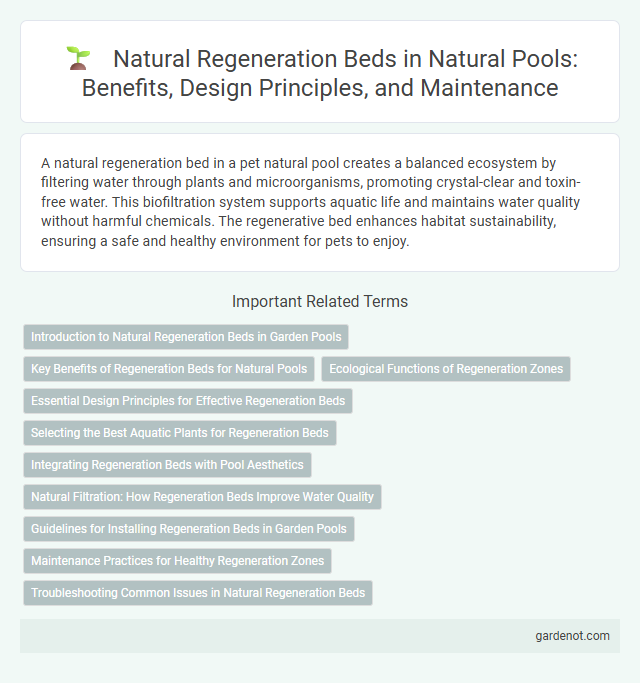A natural regeneration bed in a pet natural pool creates a balanced ecosystem by filtering water through plants and microorganisms, promoting crystal-clear and toxin-free water. This biofiltration system supports aquatic life and maintains water quality without harmful chemicals. The regenerative bed enhances habitat sustainability, ensuring a safe and healthy environment for pets to enjoy.
Introduction to Natural Regeneration Beds in Garden Pools
Natural regeneration beds in garden pools utilize plants and microorganisms to naturally filter and purify water, enhancing ecosystem balance without chemical treatments. These beds mimic wetland processes by promoting nutrient absorption and providing habitat for beneficial aquatic life, resulting in improved water clarity and quality. Integrating natural regeneration beds supports sustainable maintenance and fosters biodiversity within garden pool environments.
Key Benefits of Regeneration Beds for Natural Pools
Regeneration beds in natural pools act as biofilters, enhancing water quality by promoting beneficial microbial activity that breaks down organic matter and pollutants. These beds support aquatic plants that absorb excess nutrients, preventing algae blooms and maintaining ecological balance. The continuous natural filtration process reduces maintenance needs and creates a sustainable, chemical-free swimming environment.
Ecological Functions of Regeneration Zones
Regeneration zones in natural pools play a crucial role in maintaining water quality through biofiltration and nutrient cycling. These zones support diverse microbial communities and aquatic plants that break down organic matter and absorb excess nutrients, reducing algae growth. The ecological functions of regeneration beds enhance habitat complexity and promote biodiversity by providing shelter and breeding grounds for various aquatic organisms.
Essential Design Principles for Effective Regeneration Beds
Natural regeneration beds rely on essential design principles such as proper substrate selection, optimal water flow management, and native plant integration to enhance water purification and ecosystem balance. The substrate should consist of layered gravel and sand to maximize filtration and provide a stable root foundation for aquatic plants. Incorporating native aquatic vegetation promotes natural nutrient uptake, supports biodiversity, and maintains water clarity in natural pools.
Selecting the Best Aquatic Plants for Regeneration Beds
Selecting the best aquatic plants for natural regeneration beds is crucial for maintaining water quality and ecosystem balance in natural pools. Ideal species include water lilies (Nymphaea), hornwort (Ceratophyllum demersum), and water mint (Mentha aquatica) due to their ability to absorb nutrients, provide oxygen, and support biodiversity. Choosing plants native to the specific region enhances resilience and promotes effective biological filtration, reducing the need for chemical treatments.
Integrating Regeneration Beds with Pool Aesthetics
Natural regeneration beds enhance water purification by harnessing native plants that filter pollutants and support aquatic ecosystems. Integrating regeneration beds with pool aesthetics involves selecting visually appealing flora that complements the design while maintaining optimal biological function. This balance creates a seamless transition between the natural filtration system and the pool environment, promoting sustainability and visual harmony.
Natural Filtration: How Regeneration Beds Improve Water Quality
Regeneration beds in natural pools utilize native plants and porous substrates to filter impurities, enhancing water clarity and quality. These beds promote biological filtration by supporting beneficial microorganisms that break down organic waste and contaminants. As a sustainable water treatment method, regeneration beds reduce reliance on chemical cleaners, fostering an eco-friendly swimming environment.
Guidelines for Installing Regeneration Beds in Garden Pools
Regeneration beds in natural garden pools must be designed with eco-friendly substrates like gravel, sand, and organic matter to enhance water purification and support beneficial microbial activity. Proper sizing and placement in shallow zones with adequate water flow encourage efficient nutrient absorption and prevent stagnation, promoting a balanced aquatic ecosystem. Using native aquatic plants and maintaining a depth of 30-50 cm ensures optimal oxygenation and natural filtration for sustained pool clarity and health.
Maintenance Practices for Healthy Regeneration Zones
Natural regeneration beds in natural pools require careful maintenance practices to support healthy regeneration zones, including regular removal of debris and excess organic matter to prevent clogging and promote water circulation. Monitoring pH levels and nutrient balance helps maintain optimal conditions for native plants and microorganisms that purify the water naturally. Periodic gentle pruning of vegetation encourages growth and biodiversity, enhancing the overall ecological stability of the regeneration bed.
Troubleshooting Common Issues in Natural Regeneration Beds
Natural regeneration beds in natural pools often face challenges such as algae overgrowth, poor water circulation, and nutrient imbalances, which can disrupt ecological balance. Effective troubleshooting involves optimizing substrate composition, enhancing water flow with proper aeration systems, and managing nutrient levels through biological filtration techniques. Regular monitoring of pH, dissolved oxygen, and nutrient concentrations is essential to maintain healthy plant growth and prevent common issues in natural regeneration beds.
Natural regeneration bed Infographic

 gardenot.com
gardenot.com